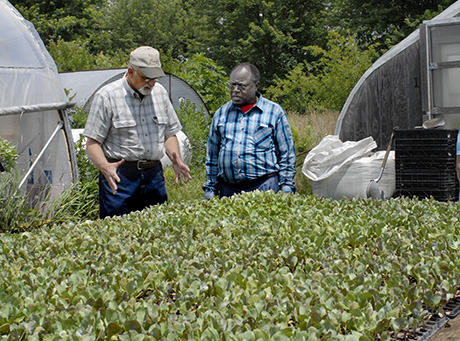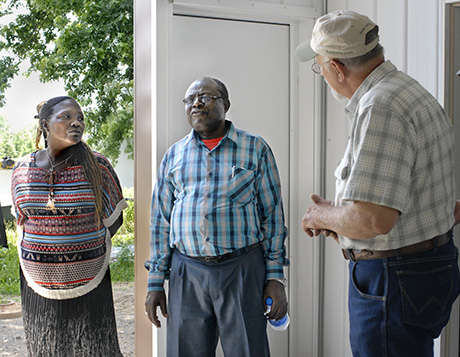
Central Illinois organic farmer Dave Bishop, left, explains his farm operation to the Rev. Elias Chakupewa who is visiting from Tanzania. Bishop is discussing local food that not only feeds the population but also generates wealth that remains in rural communities. The men are looking at thousands of storage cabbage plants started in the greenhouse in February and now going out to the fields to be transplanted. (PHOTO BY CLARE HOWARD)
Working in resistance to those trends are Dave Bishop, an organic farmer in Central Illinois, and Ken Meter, an agricultural systems analyst, writer and advocate for small farms.
Long-term change comes in small steps, said Meter, president of the not-for-profit Crossroads Resource Center in Minneapolis.
But even small steps can generate billions of dollars in additional revenue.
Using government statistics, Meter reports total food consumption in Illinois is about $37 billion annually and about 90 percent of that comes from outside the state. If each resident of Illinois purchased $5 of food from an Illinois farm each week, that would generate $3.3 billion.
Chicago plays a huge role in that food economy. About $28 billion of food is consumed each year in the Chicago metro area. If each Chicago metro resident purchased $5 of food from an Illinois farm each week, that would amount to $2.5 billion in revenue remaining within the state.
Bishop, of PrairiErth Farm outside Atlanta, Ill., wants to help central Illinois farmers capture a chunk of that Chicago metro market through a new venture at his farm about 45 miles east of Peoria. He’s developing a food hub to accept deliveries from area farmers at an almost complete 4,000-square-foot facility designed for receiving, cleaning, processing and cold storage. Staff at the facility will deal with the local inflow and send one semi-truck daily filled with food from area farms to Chicago where another food hub is already constructed to receive and begin distribution.
His goal is to get the operation up and running this year with his own farm output and start reaching out to other area farms next year. Within two years, he hopes to start shipping one semi-truck-load a day to St. Louis.
“Rural America is impoverished, and we can develop food networks to bring wealth back into our communities,” Bishop said. “We have seen food hubs develop all over the world based on the same principle: keep wealth generated on the land staying on the land.”
The current food infrastructure exists to serve major food corporations. As food shifted from small family farms to corporations, stores in rural America closed. As wealth left communities, people followed.
“If we can move our product to Chicago, we’ve got a shot,” Bishop said. “Our opportunities with farmers markets are limited. But we can’t be sending a little box truck that’s half full to Chicago. We’ve got to have volume to be cost effective.”
Meter, who has studied the economics of food production for more than 40 years, said, “Our current food infrastructure is built to support transportation over long distances and powerful businesses that influence and have access to the political structure. There are huge losses with the current system. We’ve lost rural population, rural schools, our rural youth, the rural economy.”
Through his work, Meter has been documenting these losses over four decades.
He points out, however, that the once-efficient system of food supplied by local farm families has not necessarily been replaced by a better more efficient system.
Under the current farm economy, he calculates average losses of about $60 an acre planted in commodity corn. Tariffs and trade problems are making losses on soybeans also problematic.
“That loss of $60 an acre is multiplied by the thousands of acres in corn. It’s based on the total cost of farming including buying the land and equipment,” he said. “The U.S.D.A. is predicting a seriously low ag economy for five to six years. How many farmers can sustain those losses? The whole farm sector is selling at a loss. Tariffs on soybeans mean farmers face a lot of uncertainty. It’s hard to know how much of this discussion on tariffs is bluster.”
Meter speculates whether we could be facing another massive farm crisis like the one in the 1980s.
Also part of this assessment of the current farm economy should be the cost of food-related health conditions such as diabetes, Meter said. In Illinois alone, the financial cost of diabetes is nearly $9 billion.
The current food system dominated by corporations adds to inequality and as long as that continues, Meter said the need will exist for food stamps.
One of the regions he studies is Hawaii where there is currently more money generated through food stamps than through farm income.
“At one time in our history, people could be poor but with some land they could have enough to eat. Now people earn money, but they are poor, and they have to work harder and harder to stay afloat,” he said. “There is steep inequality. Those with the most power and wealth try to maintain a system with steep inequality.”
Revamping the food system is an important element in creation of a more just and equitable society, he said.
The economic potential of regional food is one focus of Tory Dolhoff, rural development coordinator and director of communications and outreach for the Greater Peoria Economic Development Council and co-chairman of the Regional Fresh Food Council.
“We are looking at the economic and business development opportunities beyond farmers markets,” Dolhoff said. “There is a whole world of untapped startup and business opportunity possibilities there.”

The Rev. Elias Chakupewa, center, and his wife Lucy talk with Dave Bishop of PrairiErth Farm about Bishop’s new food hub with 4,000 square feet for washing, sorting and shipping produce from surrounding Central Illinois farms to markets in Chicago. Chakupewa is from Tanzania and is interested in learning about developing new markets for farmers in his country. (PHOTO BY CLARE HOWARD)

Recent Comments